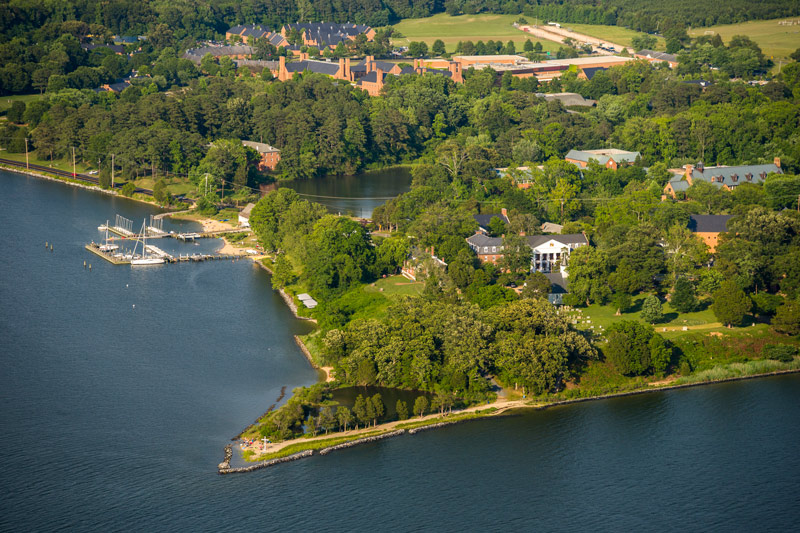Friday
Tomorrow my seniors graduate and, in the course of the ceremony, we will sing the school song. The lyrics borrow a line from Wordsworth’s Tintern Abbey, and at one point during our singing the students will all laugh. It happens every year and it will happen tomorrow. Today’s post explains why.
My colleague Jennifer Cognard-Black, who composed the lyrics, makes much of our pastoral setting. (My music colleague David Froom wrote the soaring music.) Can you pick up the passage from the Wordsworth poem that the students respond to? (It’s in the chorus so don’t point to the daffodils.)
A blue and gentle river flows toward the Chesapeake
And fastened to its golden shore the school our spirits seek.
Its lush and lovely woodlands enfold a tranquil bay
That feeds and cools this fruitful earth sustaining day by day.
Chorus:
St. Mary’s College of Maryland, green to the very door—
In Maryland we strive and seek and find our heart’s own shore.
Bright daffodils and flaxen fields beneath a quiet sky
Inspires us to see anew and always question why.
The moving water mirrors all that stirs within our souls
Its harmony of wind and wave enlivens and consoles.
Chorus:
St. Mary’s College of Maryland, green to the very door–
In Maryland we strive and seek and find our heart’s own shore.
Here’s the source (in more ways than one):
Once again I see
These hedge-rows, hardly hedge-rows, little lines
Of sportive wood run wild: these pastoral farms,
Green to the very door; and wreaths of smoke
Sent up, in silence, from among the trees!
The full title of the poem is “Lines Composed a Few Miles above Tintern Abbey, On Revisiting the Banks of the Wye during a Tour. July 13, 1798.” That Wordsworth is looking down at the Wye River may be one reason why Jennifer thought of the poem as we too are located on a river: the St. Mary’s River flows into the Potomac which, after a few miles, flows into the Chesapeake. Other factors may have entered in as well. For instance, the poem functions as a five-year reunion, with Wordsworth returning to a place he visited as a younger man. Also, St. Mary’s has lots of of trees and greenery, which sportively run up to the very doors of the residence halls and academic buildings.
I can’t imagine a better poet for Jennifer to cite in a St. Mary’s song. We have our own “Daffodil Gulch,” where the flowers gleefully compete with the sparkling waves of the river, and years later the students recall many “setting suns” from the vantage of Church Point. At alumni reunions they have told me that sometimes, when they are sitting in “lonely rooms, and ‘mid the din/Of towns and cities,” they think back to their time here. Wordsworth captures what they strive to express:
These beauteous forms,
Through a long absence, have not been to me
As is a landscape to a blind man’s eye:
But oft, in lonely rooms, and ‘mid the din
Of towns and cities, I have owed to them,
In hours of weariness, sensations sweet,
Felt in the blood, and felt along the heart;
And passing even into my purer mind
With tranquil restoration… (Tintern Abbey)
All this is well and good. The students don’t laugh at our school song because they pick up Wordsworth allusions, however. They laugh because the favorite local student hangout is a tavern named “the Green Door.”
Jennifer swears that she didn’t have this Green Door in mind when she wrote the lyrics, and I believe her. As English professors, however, we are well versed in the intentional fallacy and the elusive ways of language. Who knows what transpired in the nether regions of Jennifer’s mind?
I actually love the laugh of recognition that the song elicits. The Green Door has functioned as a rite of passage no less than the College.
For instance, when students turn 21, the Green Door is where they go to buy their first drink. Sometimes they go earlier with fake ids, which is its own rite of passage. The symbolism of the door, suggesting a passage from childhood to adulthood, could not be better chosen.
And then there is the color. When I teach Sir Gawain and the Green Knight, I note that, all over Great Britain, one finds “Green Man” taverns, homage to the rambunctious fertility god that Christianity was never able to stamp out. It is the same god that defeats the rigid Pentheus in The Bacchae, and as Puck he unleashes sexual chaos in Midsummer Night’s Dream. College students instinctively bond with this god as they seek to develop their own identities apart from their parents. They are testing boundaries, and alcohol, sex, and other stimulants are one way they do this. Schools work hard to get the right balance between freedom and prohibition.
So tomorrow, when we sing our romantic-in-every-sense-of-the-word school song, the students will think back to their time by the river and in the woods, to the teachers that challenged them “to see anew and always question why,” and to the ways that they have changed. They came as innocent adolescents and now they are passing through a green door to adulthood. Jennifer’s lyrics acknowledge all of this.
Previous Commencement posts
Robert Creeley: Rituals of Commencement
Martin Espada: Imagine the Angels of Bread
Steve Kowit: A Poem for Commencement
Hamlet Instructs the Class of 2015
Toni Morrison: Obama Tells Black Graduates to Soar
Derek Walcott: No Calendar Except for This Bountiful Day
Theodore Roethke: A Villanelle for Graduating Seniors
Emily Dickinson: Brains Deeper Than the Sea
Lucille Clifton: Children Commence, Parents Let Go
Christopher Smart: Crown My Head with Ample Square Cap


